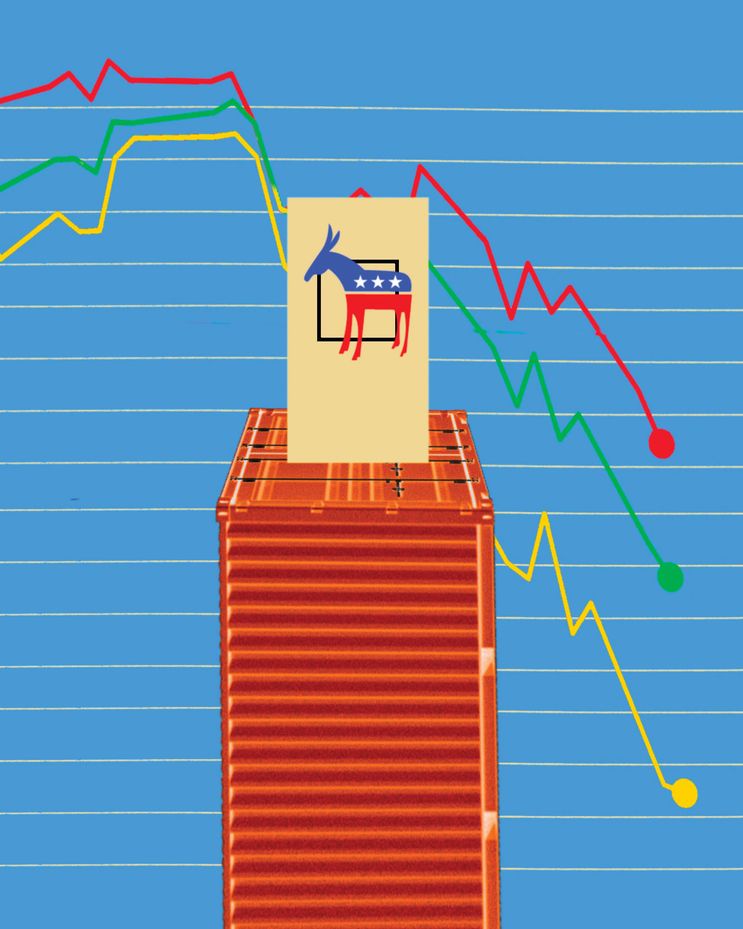
OPINION:
President Trump is wagering tariffs on Republican majorities in Congress.
Even with most of his reciprocal tariffs temporarily suspended, these import taxes make a recession more likely, and Mr. Trump won’t be able to turn around the economy quickly enough to save the Republicans’ bacon.
Trump’s tariffs and prices
He is raising the average tariff on imports from less than 3% by about 20 percentage points. Estimating the exact amount is difficult because some imports from China, whose high reciprocal tariff remains in force, will be sourced from lower-tariffed countries such as Vietnam and domestic suppliers.
Foreign producers can withstand modest increases in these taxes, but expecting China’s exporters to absorb more than a fraction of the 125% in additional duties would be ludicrous.
The overall effect on U.S. inflation shouldn’t be huge because imports represent only about 11% of gross domestic product. However, the influence will be felt everywhere because almost everything we make and use has some imported components.
Mr. Trump could make the average American better off by cutting income taxes by the $600 billion in potential new revenue collected because foreign exporters, not U.S. purchasers, will pay some portion.
However, Mr. Trump can’t lower taxes fast enough by executive order. Even with Republican majorities in Congress, he can’t lower income tax rates quickly.
Recession fears
Mr. Trump inherited a pretty good but vulnerable economy.
Last year, GDP grew by 2.8%, but American voters were dissatisfied because of inflation. Campaigning for reelection, he promised to bring down prices. Now, his tariffs will send prices the other way.
Moreover, economic recoveries are often powered forward by borrowing. Those peter out sometimes because consumers need a breather to pay off their debts.
Credit card delinquencies are at levels not seen since the Global Financial Crisis of 2008. Recession fears have pummeled consumer confidence, and retail sales have been slowing.
In January, economists were forecasting 2025 growth at 2.0%. With imported goods accounting for 11% of GDP, a 20% increase in taxes on those should lower GDP by only about 0.3%
However, consumer boycotts abroad and retaliation will negatively affect U.S. exports. China has boosted its tariffs on U.S. products, and major trading partners have taken or are considering similar actions.
Moreover, supply disruptions caused by businesses seeking to substitute foreign products and components from higher-tariff countries for lower-tariff or domestic sources are not well captured by econometric models.
The odds of a recession or terribly lethargic growth are at least 50%.
Midterm elections
Democrats may be pixilated about their message, but their voters are not hiding behind a bush. They came out in force for the recent special elections in Florida and elsewhere, where Democrats either won or the Republicans prevailed by margins much thinner than in November.
Those outcomes reflected Democrats’ natural advantage in off-year elections. Their supporters are more educated, politically engaged, liberal and likely to vote than are Republican supporters generally and Mr. Trump’s base specifically.
No politician or political party is recession-proof. If the economy swoons and does not measurably improve by the summer of 2026, the Republicans will relearn a hard lesson about the primacy of economics.
Trump’s wager
Essentially, Mr. Trump is betting he can quickly negotiate new trade agreements with Japan, the European Union and others. That would heal many supply-side problems, but those agreements will be difficult to accomplish.
Those deals can’t merely go zero for zero on tariffs but must address nontariff barriers such as import quotas, government regulations, subsidies and domestic taxes biased against imports.
That’s terribly complex and makes writing tax legislation in Congress look like a third-grade spelling test.
The administration is obsessed with value-added taxes, which are important sources of revenue for most foreign governments, are not discriminatory and won’t be removed.
Either the Trump team finds an exit route to eliminate those taxes, or we won’t get meaningful new trade agreements.
The Office of the U.S. Trade Representative has only about 225 employees. Even under the best circumstances, it can’t possibly negotiate enough new agreements within a year.
Hard time ahead for Trump’s agenda
Americans are likely facing stagflation, which is persistently rising prices in the face of a recession, much slower growth and more unemployment.
The president is accomplishing many elements of his agenda, including immigration and higher education reform, but beyond a tax bill later this year, he faces a tough time.
After that, his support among voters and Republicans in Congress will wane.
In his final two years in office, he will likely confront a Democratic House and perhaps Senate, have difficulties funding his deportation initiatives and be subject to intense scrutiny of his cultural agenda.
• Peter Morici is an economist, an emeritus business professor at the University of Maryland and a national columnist.
















